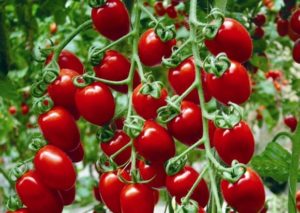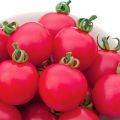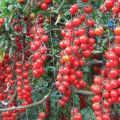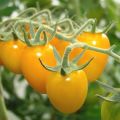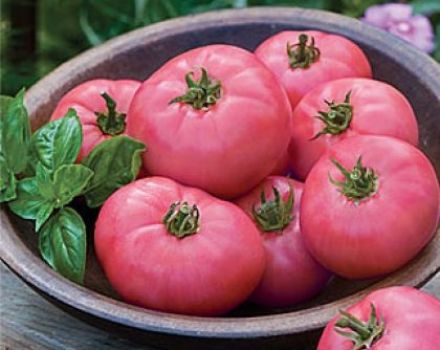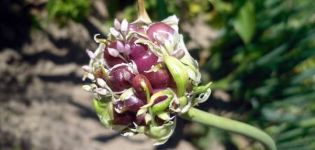Characteristics and description of the Slasten tomato variety, its yield
The variety was created in Russia in 2000, included in the State Register of Breeding Achievements in 2008. In the south, Slasten's tomato is planted in open ground, in Siberia, the Urals, the Far East, it is planted under film. This is an early variety: from planting seedlings in the ground to picking up ripe fruits, it takes 90 - 95 days.
general information
Description of the variety - bushes are indeterminate, standard, in height at the summer cottage up to 1 - 1.1 m, in greenhouses - up to 1.3 m. The foliage is rare, the leaves are medium-sized, dark green. The first brush appears above 8 - 9 leaves, the next ones - every 3 leaves. On one brush, 30 - 40 tomatoes.
Fruit characteristics: slightly elongated in shape, cylindrical. Ripe tomatoes are scarlet and burgundy. They have a dense skin. Sweet with a honeyed aftertaste. Fruit weight - 30-50 g, on the first clusters - up to 70 g. There are 4 seed chambers, the presence of dry matter is 6%. They are eaten fresh, put in salads, canned, squeezed out, made ketchup and lecho. Not suitable for barrel pickles.
Benefits and cons
Tomatoes have several advantages:
- small sweetish tomatoes;
- the skin does not burst;
- tied together;
- the variety is resistant to sudden changes in temperature;
- tomatoes ripen quickly;
- easy to transport;
- the yield is high: up to 2 - 2.5 kg of fruits are harvested from a bush, up to 8 kg from 1 m², and up to 10 kg in a greenhouse;
- bushes can grow even on impoverished lands;
- stored for a long time;
- the variety is moderately resistant to brown spot, root rot, late blight;
- good for canning.
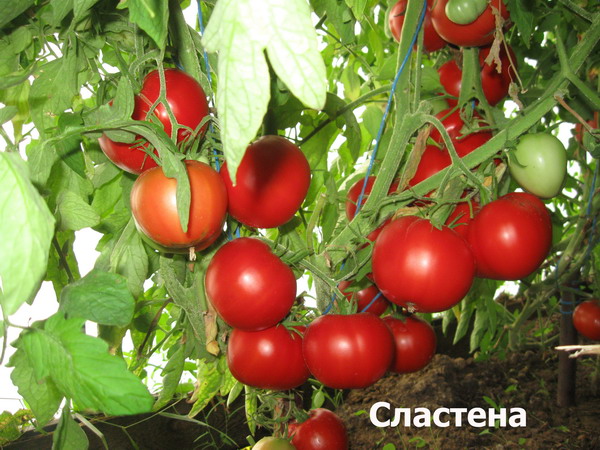
Among the small minuses - the bushes must be tied up, the stepsons must be cut off, the branches supported.
Sowing seeds
Tomato seeds of the Slastena Nastya F1 variety are sown at the end of March. If you purchased seeds on the market, then they are disinfected. The seeds are poured into a gauze bag and lowered for 20 minutes. in a solution of potassium permanganate (pour 1 g into half a glass of clean water). It is not advised to keep the seeds in potassium permanganate for longer than 20 minutes, as their germination decreases. Then rinse the seeds with clean water.
Instead of potassium permanganate, you can make a soda solution. Pour 0.5 g of baking soda into half a glass of water. Place the seeds in a soda solution for 24 hours.
Make the soil from equal parts of peat soil, turf soil, humus. Pour 1 teaspoon of superphosphate, carbamide, potassium sulfate on one bucket of prepared soil. Disinfect the soil by spilling it with a strong solution of potassium permanganate. Then let the soil sit wet for 10 days to allow the beneficial bacteria to grow.
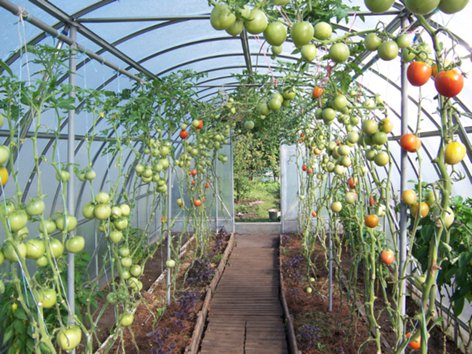
Place the seeds in the soil. Sprinkle with earth so that the seeds are 1 cm deep. Pour from a spray bottle. Cover with foil, put in a warm place. The air temperature should be 25 - 30 degrees.
Growing seedlings
When shoots appear, remove the film. Place the box on the windowsill. Seedlings dive when 2 true leaves appear, transplanting them into peat cups. To grow seedlings in the absence of the sun, supplement it with lamps.
Water your seedlings with a spray bottle in the morning. 2 weeks before transplanting, start hardening the bushes by taking them out to the balcony. First, place them on the loggia for 5 minutes, then increase the interval for finding the seedlings in the open air.
Transplanting
In autumn, spread 4 kg of manure on 1 m² of land, dig up the ground to the depth of a shovel. In the spring, scatter the same amount of manure over the soil, but the manure must be rotted. Sprinkle 1 tbsp on 1 m² of soil. a spoonful of potassium chloride and 5 tbsp. spoons of superphosphate. Dig the soil a second time. Although, in general, this variety is not picky about the composition of the earth.

Dig holes 15 cm in diameter and 30 cm deep. Drive in the pegs. Place the seedlings in the holes. 4 bushes are placed on 1 m², they do it in a checkerboard pattern. Water the plantings liberally. Tie up the bushes.
Care
Feed the tomatoes for the first time 10 days after planting on the site. Pour 1 kg of manure into a ten-liter bucket of water. Let it stand for a while. Then water, being careful not to hit the leaves. Do top dressing at the same time as watering. Loosen the soil after each watering or rain. After the first feeding, mulch the soil with straw, pine needles in a layer of 5 cm.
In addition to tying the trunk, you also need to tie the brushes. If you planted seedlings in a greenhouse, then form a bush in 2 stems, if in open ground - in 3 stems. Cut off stepchildren every 10 days.
Diseases and pests
Be sure to take preventive measures. Ventilate the greenhouse daily. The variety tolerates sudden changes in temperature, but it is better to observe the temperature in the greenhouse.
Tomatoes are very fond of slugs. Pull the weeds in time. Sprinkle lime on the ground, but so that the soil does not become alkaline. You can add coarse sand, ground eggshells or nuts. Very often, aphids attack the bushes. To eliminate planting pests, spray with Bison. If a whitefly appears on the bushes, spray with Confidor.
Reviews of the variety are extremely positive: children love small sweet cherry tomatoes.
Other varieties of tomatoes with similar names
In addition to the Slastena variety, 3 more varieties with similar names are included in the State Register.
Variety Lakomka is included in the State Register in 2003. The bushes are determinant, that is, they stop growing when flowers appear, up to 55 - 60 cm high. The variety is early ripe. Semi-sprawling bushes. Round-shaped tomatoes, weighing 100 - 120 g. Ripe tomatoes are raspberry-colored, they have a wonderful dessert taste. Collect 6 - 7 kg from 1 m². The variety is drought tolerant. It is immune to top rot.
Variety Sladkoezhka is included in the State Register in 2009. Early maturing variety. Bushes are indeterminate, they need to be formed into 1 stem and tied up. Refers to cherry tomatoes, fruit weight 35 - 40 g. Tomatoes are round, excellent taste. Planted on 1 m² of 4 bushes.
The Anastasia variety is included in the State Register in 2007. The bushes are determinant, but they still need to be formed and tied up. Fruits are elliptical, red in color. Tomato weight 100 - 120 g. They have good taste. Collect from 1 m² of 8 kg of fruit.

